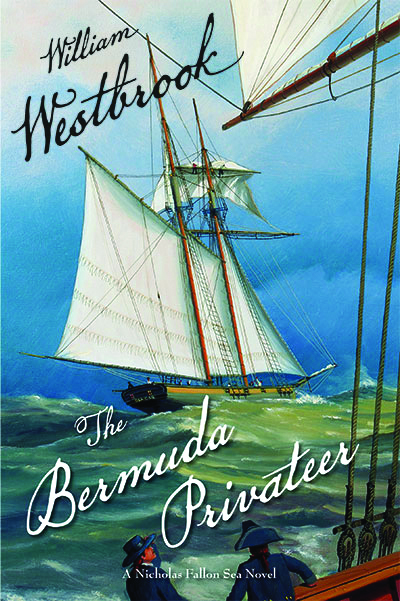William Westbrook’s “The Bermuda Privateer"
The four decades that unfolded between the first shots in the American war for independence and Napoleon’s surrender at Waterloo are fertile ground for fiction writers, especially those who set their action aboard the fast and powerful warships of the era.

Advancing a sea-going protagonist though the ranks of the Royal Navy across an endless run of exotic locales and through shifting geo-political forces is a rich tableau upon which to build a character, a book, or even a long-running series. Armchair sailors have proven to be an insatiable audience for these stories, especially after the author stirs in hurricanes, pirates, duels, cannons, shipwrecks, a hearty dose of political intrigue, and the occasional encounter with an alluring native.
Source material is rich, especially on the British side of things where record-keeping, reports, and documented procedures were an important part of Royal Navy culture. The era’s warships, particularly the British warships, were among the largest moveable objects ever built by man and carried aboard a wide-ranging array of technology, weaponry, and specialized knowledge. These ships were manned by sailors and soldiers who, collectively, represented a densely-packed microcosm of western society. More than two centuries later, the possibilities for a creative spirit remain far-reaching. This is a well-tilled plot of land.
The genre’s standard-bearers are C.S. Forester’s pioneering, 10-book Horatio Hornblower series and Patrick O’Brian’s astonishing, yet difficult-to-penetrate, 20-book Aubrey / Maturin series. Although they bear two very different approaches to the material, this pair of series is firmly established and broadly known, having spawned movies, reference books, and even soundtrack albums. A third, equally sprawling series is now established in the canon alongside the legends: Dewey Lambdin’s entertaining Alan Lewrie novels, currently standing at 23 books and counting. Earnest readers who bailed on the Aubrey and Maturin series due to the sheer density of the prose will find an easier access into the more free-wheeling, rowdier Alan Lewrie series.
Into this sea-going world arrives “The Bermuda Privateer,” an energetic first novel from William Westbrook, a retired advertising executive and active Chesapeake Bay sailor. Having cut my teeth on Hornblower, labored alongside Aubrey, and spent a hundred hours with Lewrie, I found the adventures of Westbrook’s Captain Nicholas Fallon to be fresh and fun.
Westbrook is a first-rate and efficient storyteller, and “The Bermuda Privateer” is a salty and colorful run through a series of late 18th-century adventures in Bermuda, The Bahamas, the Gulf Stream, and Spanish Florida. The tale covers a lot of sea miles, and Westbrook remains nicely focused on action and forward progress throughout. By the end, his plots fit together neatly and across a logical timeline.
“The Bermuda Privateer” is a well-drawn introduction to Nicholas Fallon, formerly of the Royal Navy and now representing the pride of and business interests in his native Bermuda. Fallon stands in command of the eponymous ship and in the center of the action throughout the story. Along the way, the reader meets Fallon’s friends, his crew, his enemies, and his sponsors. Together we all have a fast-paced ride across their warm and active water-world. While you do not need to be a history nut or a tall-ship fiend to enjoy the story, it does help to be a sailor. It is obvious that a sailor wrote the story, as sailing sections are technically accurate, complete, and well-presented.
Fans of Horatio Hornblower, Jack Aubrey, and Alan Lewrie will be naturally drawn to this new story, and they won’t be disappointed. I finished “The Bermuda Privateer” in about four sessions—it is a fast, engaging read. By the second half of the book, I found myself consciously slowing down and savoring the story. All the plotlines fit together neatly in the final pages. I am looking forward to the next installment, as Westbrook promises another one is on the way. Highly recommended. ~Reviewed by Dave Gendell
The author will do a book signing at the Mariners' Museum at 3 p.m. October 21.




